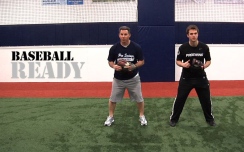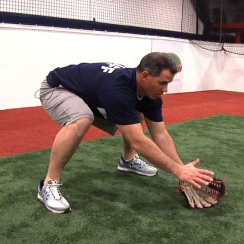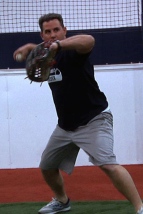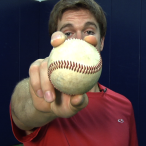One of the most popular positions for young ballplayers to play is the infield. It is also one of the most difficult. In order to enhance your skills and play at the next level, you must practice and be mechanically sound. This ProSwing Tip of the Week will focus on a three-step progression that encapsulates the proper way to field a routine ground ball. We will discuss the three phases of a ground ball, and how to master each one.
Phase 1 – Pre-Pitch to Baseball Ready Position
- Create a Routine – Just like we illustrated in our How to Hit a Baseball videos, we need to establish a Routine and Rhythm as a fielder. A good way to do this is to slightly sway side-to-side as the pitcher starts his windup. As the ball is released and then crosses the hitting zone, you’ll want to transition from swaying side-to-side into a hop that lands you on the balls of your feet with your hands out. This is your Baseball Ready position.
- NOTE: When a coach says, “Show me a fielding position; do NOT go straight into a fielding position. This is unrealistic and a bad habit that coaches instill in players. Instead, get in your “Baseball Ready” position.
- Baseball Ready – Remember, we’re tall, on the balls of our feet, and our glove is out in front.
Phase 2 – Baseball Ready Position to Fielding Position
- Attack – Regardless of how hard a ball is hit, we generally teach to attack the baseball. Go towards it. The goal is to reduce the number of hops the baseball will take. This will put YOU in the driver seat and can possibly eliminate a bad hop.
- Form – As you go down to field the baseball, make sure your chest is up, your butt goes down, and you bend both knees at the same time.
- Glove Out / Eyes Behind – We want to field the ball with our glove out and inside our glove side leg. Our eyes must be behind the baseball, ensuring that we are not bending at the waist, and we will be able to use our momentum correctly for phase three.
 Triangle – When fielding the ball properly, your two feet and your glove should make an equilateral triangle.
Triangle – When fielding the ball properly, your two feet and your glove should make an equilateral triangle. - Hands at 6 and 2! – We are now deep in our fielding stance with our glove hand at 6 o’clock and our throwing hand at 2 o’clock.
- FIELD THAT BALL! See it into your glove. Make sure our eyes aren’t on the runner, you must field the ball before you throw a runner out
Phase 3 – Fielding Position to Throwing Position
- NOTE – You must remember that we work from the ground up. We don’t stand straight up from our fielding position, but rather come up as an airplane would as it takes off.
- Rhythm and Replace – Like a snowball rolling down a hill; we don’t want our momentum to stop from our fielding position. We want to replace our throwing side foot with our glove, pushing our instep towards our target. As we do this, our arm will separate from our glove and will go back to throw.
- Glove Side Foot / Power Position – As your momentum continues to go forward and you put your glove side foot down, you should be in our Power Position. (Click here to watch the Top
 Gun Throwing Series Video)
Gun Throwing Series Video) - NOTE – You should be strong on your front side, with your lead elbow pointing to your target, ensuring accuracy. Chin to front shoulder. Release the baseball with your four-seam grip (Click here to watch the Finding the Seams Video)
- Don’t Stop the Rhythm – Your rhythm and momentum doesn’t stop on release, in fact; it isn’t complete until you follow through with your throw.
Conclusion
Every year as you get older and play high levels of baseball, the game gets a little faster. Proper mechanics in fielding a ground ball will ensure the quickest and most efficient way to make the play. Remember to perfect your footwork, be consistent with your routine and rhythm, and never stop practicing!
